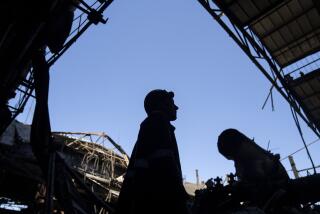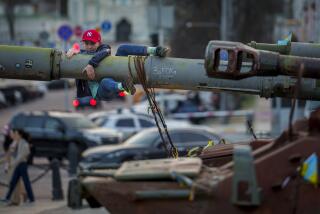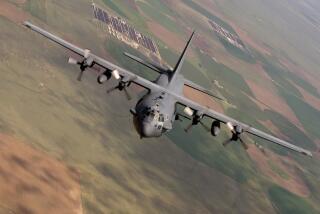NEWS ANALYSIS : Weapons Plants Inviting Targets for New Attacks
- Share via
WASHINGTON — By concentrating on what remains of Iraq’s weapons-making facilities, the United States and its allies have chosen a focus for their military and political firepower that offers almost unlimited targets for future operations if they are deemed necessary.
Although U.N. inspectors have spent 21 months searching out and destroying armaments facilities throughout Iraq, experts agree that dozens of plants involved in the development and manufacture of Iraqi nuclear, biological and chemical weapons still stand.
All of these targets are in fixed positions well known to U.S. war planners. And because many are largely unprotected and in thinly populated areas, allied aircraft could target them without significant risk of being shot down or of inflicting large numbers of civilian casualties.
To further reduce the risk of U.S. losses, some of the more than 160 Tomahawk cruise missiles left aboard warships in the Persian Gulf and the Red Sea could be used, as such missiles were on Sunday.
Also, acknowledged one Pentagon official, such strikes--directly tied as they are to the issue of Iraq’s weapons of mass destruction--would have the advantage of satisfying the conditions of many allies, who have been unwilling to punish Iraq in ways that go beyond the letter of U.N. Security Council resolutions.
Finally, several experts in and out of the U.S. government contend, targeting such facilities would hit Iraqi President Saddam Hussein where it would really hurt. His programs for weapons of mass destruction are one of his most cherished and most zealously pursued priorities because--for some--they represent a key source of status in the Middle East.
“It’s much worse for Saddam Hussein than bombing the headquarters of his Republican Guard, because he really cares about his weapons programs,” Diana Edensword, an expert on Iraqi armaments with the Wisconsin Project on Nuclear Control, said.
And hitting these targets would move the allies away from a strategy of responding to Iraqi provocations in tit-for-tat fashion.
“It’s the start of a good strategy,” said David A. Kay, who led several U.N. weapons inspection teams into Iraq and is now secretary general of the London-based Uranium Institute. “It is hitting something that is valuable over the long run, as opposed to shooting down a MIG-29 or striking an ancient SAM missile.”
If the Clinton White House should ask for other options, U.S. officials said they still have long lists of targets that would involve not Iraq’s weapons-making capability but its military facilities that have been directly engaged in the latest series of Iraqi provocations.
Those include dozens of airfields at which Iraqi planes have been consolidated, and from which Baghdad has launched several of the aircraft violating the declared “no-fly zones”.
In the view of Washington and some of its Western allies, the International Atomic Energy Agency in Vienna, which has supervised inspections of nuclear facilities in Baghdad, has been too willing to accept Hussein’s arguments about the significance of specific facilities.
The largest category of ready targets may be storage sites within 40 miles of Baghdad whose locations are precisely known to U.S. officials. Those facilities house some 700 precision-controlled machine tools that have been marked for destruction by U.N. inspectors.
Other known weapons complexes left intact by U.N. inspectors include:
Iskandariya, a large foundry roughly 30 miles south of Baghdad, in which Iraq appears to have cast steel casements for possible nuclear weapons use.
* Hamath, a magnet-test facility located just outside an earthen berm surrounding the weapons complex of Tuwaitha, east of Baghdad. It has been inspected by the U.N. Special Commission twice--once in June, 1991, and again in November, 1992--and was found to be a key component of Iraq’s effort to enrich uranium for use in nuclear weapons.
* Hatteen, less than 100 miles southwest of Baghdad, was visited by U.N. weapons experts in November, 1992, when the inspectors found super-gun components and the instruments needed to measure the power of high explosives.
* Fallouja, due west of Baghdad about 30 miles, is the place where U.N. inspectors in June, 1991, were held at the complex’s gates, where they watched as Iraqi trucks carried off the contents--magnets for a calutron, a key element in the uranium-enrichment process.
* Nasr State Establishment is one of several facilities that lie on the road between Baghdad and Hussein’s birthplace of Tikrit--a strike avenue that would have potent symbolic significance to the Iraqi leader.
More to Read
Sign up for Essential California
The most important California stories and recommendations in your inbox every morning.
You may occasionally receive promotional content from the Los Angeles Times.














